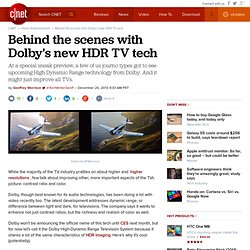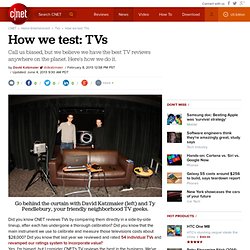

HARP. HARP is an open source toolkit for rapid prototyping of new HEVC / H.265 video codec extensions.

Our motivation for creating HARP lies in the simple idea that a well-chosen development environment allows to focus time and resources more on the design stage of new HEVC extensions and less on subsequent implementation and debugging tasks. HARP might be interesting to you if you plan to analyze, adapt, or extend the C++ reference implementation of HEVC, the HEVC Test Model (HM). That's probably the case if So what is it that HARP provides? While existing analyzers are restricted to decoder side and almost all are closed source only, HARP allows detailed analysis like encoder-side RDO behavior or decoder-side CU mode visualization inside the reference implementation of HEVC, HM-14.0.
Important update: Starting with the ICIP2014 conference in Paris, HARP is now available in version 1.03: HARP_v1.03.tar.gz (Linux only). Contact: springer@LNT.de. Luma HDRv - encoding and decoding of HDR video. Video Quality Experts Group (VQEG) Active Projects Audiovisual HD (AVHD)

YUV格式详解 - SearchSun的专栏. YUV是指亮度参量和色度参量分开表示的像素格式,而这样分开的好处就是不但可以避免相互干扰,还可以降低色度的采样率而不会对图像质量影响太大。

YUV是一个比较笼统地说法,针对它的具体排列方式,可以分为很多种具体的格式。 转载一篇对yuv格式解释的比较清楚地文章,也可以直接参考微软的那篇文章。 这里转载有人已经翻译过的,个人认为已经翻译的很不错了,遂放弃翻译。 YUV格式解析1(播放器——project2) 根据板卡api设计实现yuv420格式的视频播放器 打开*.mp4;*.264类型的文件,实现其播放。 使用的视频格式是YUV420格式 YUV格式通常有两大类:打包(packed)格式和平面(planar)格式。 MEDIASUBTYPE_YUY2 YUY2格式,以4:2:2方式打包. H.264 学习笔记(四) - will.v. 变换与量化 1、 变换量化的过程如图3-1所示: 图3-1 2、 H.264 对4×4 的图像块(亮度块或Cr、Cb 色度块)进行操作,则相应的4×4DCT 变换矩阵A为: ,则: H.264 对4×4DCT 中的A 进行了改造,采用整数DCT 技术,有效地减少计算量,同时不损失图像准确。

其中,d=c/b(≈0.414)。 Behind the scenes with Dolby's new HDR TV tech. While the majority of the TV industry prattles on about higher and higher resolutions , few talk about improving other, more important aspects of the TVs picture: contrast ratio and color.

Dolby, though best known for its audio technologies, has been doing a lot with video recently too. The latest development addresses dynamic range, or difference between light and dark, for televisions. The company says it wants to enhance not just contrast ratios, but the richness and realism of color as well. Dolby won't be announcing the official name of this tech until CES next month, but for now let's call it the Dolby High-Dynamic Range Television System because it shares a lot of the same characteristics of HDR imaging. Here's why it's cool (potentially). The multiple levels of picture quality There are three aspects to the picture that Dolby hopes to improve: Brightness, contrast, and color.
Increasing the brightness of a TV, in itself, isn't difficult. The last aspect is color. How we test: TVs. Did you know CNET reviews TVs by comparing them directly in a side-by-side lineup, after each has undergone a thorough calibration?

Did you know that the main instrument we use to calibrate and measure those televisions costs about $28,000? Did you know that last year we reviewed and rated 54 individual TVs and revamped our ratings system to incorporate value? Yes, I'm biased, but I consider CNET's TV reviews the best in the business. We've come up with a set of tools and procedures designed to arrive at unbiased results by utilizing industry-accepted video-quality evaluation tools, objective testing criteria, and trained experts. The goal is to tell you what TVs are better than others, and why.
Test environment and equipment The most important piece of test equipment is a trained, expert eye. Our main TV lab is a 1,200-square-foot room where we set up our comparison lineups. Xplore.ieee.org/xpl/RecentIssue.jsp?punumber=76. Spatial frequency, k-space, MR image resolution and contrast. Derf's Test Media Collection. All video sequences are in the uncompressed YUV4MPEG format used by the mjpegtools project unless otherwise indicated.

This is the format accepted by the Theora encoder tools. Some encoding parameters such as framerate that were missing from the raw data have been guessed or inferred, and may be incorrect. All sequences listed here were available at one time on publicly accessible servers or were given to us explicitly to host here, and are believed to be freely redistributable. When available, the appropriate copyright information is included.
Some may impose additional restrictions or limitations. SD Content and Below HD Content and Above Full Sequences Since the files in this section can be very large, they have been compressed with xz. 1These were converted from 16-bit linear RGB to Y'CbCr using Tobias Oelbaum's sgi2yuv utility, written expressly for this purpose. MPEG China.
3D CineCast.